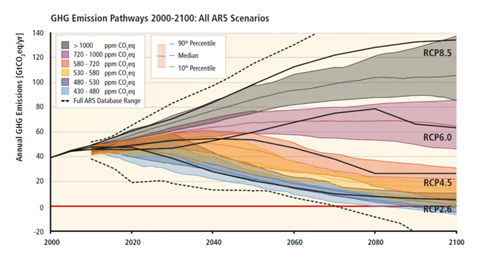Monitoring and managing the main risks, opportunities and environmental impacts
An update of the Risks and Opportunities arising from climate change is being carried out in 2020-2021, following the recommendations of the "Task Force on Climate-related Financial Disclosures (TCFD)". The recommendations of this methodology are based on four axes: governance, strategy, risk analysis and metrics, and aim to improve the organisation's resilience to different climate scenarios.
The methodology will make it possible to establish which economic impacts of climate change could affect the company. TCFD recommends that organisations exposed to the risks of climate change consider using scenario analysis to inform their strategic and financial plans and to report on how resilient to different climate change scenarios their strategies are. The objective is to assess and analyse risks and opportunities, both from a purely climate and transitional perspective - indirect regulatory, political, legislative and market changes, and subsequently evaluate the impact from an economic and financial point of view.
Climate scenarios
The climate scenarios of all countries have been analysed following the recommendations of the TCFD. The analysis aims to consider and better understand the development of Cellnex’s activity under various future climate scenarios, to improve the organisation's resilience to different changes.
Climate scenario analysis is the previous step to undertake the assessment of risks and opportunities arising from climate change, in accordance with the TCFD recommendations and the CDP punctuation criteria. Climate scenarios are also a prior step for mapping the sustainability impacts.
Climate-related scenarios allow an organisation to explore and develop an understanding of how the physical and transitional risks and opportunities of climate change could plausibly impact the business over time. Scenario analysis therefore assesses a range of hypothetical outcomes by considering a variety of alternative plausible future states (scenarios) under a given set of assumptions and constraints. According to the TCFD methodology, there are two main types of scenarios to be analysed: physical and transition.
Physical scenarios
Physical scenarios consider the concentrations of greenhouse gases (GHGs) in the atmosphere and the physical characteristics of the climate to assess the possible risks that climate change may cause, using the scenario developed by the Intergovernmental Panel on Climate Change (IPCC) in its fifth assessment report (AR5). In this regard, the scenario was based on representative concentration pathways (RCP) to define a range of climate scenarios. RCPs measure the cumulatively human emissions of all GHG sources as for 2100. In this way, four RCPs were established based on simulations of GHGs in the atmosphere as shown in the following figure.

To analyse physical climate scenarios, it is recommended to take into consideration the worst possible scenario, to know and be able to anticipate the most severe impacts that they may have on organisations. That is why the RCP 8.5 scenario has been selected to analyse the climate projections. RCP 8.5 shows a Business-as-Usual (BaU) scenario, in which GHG emissions would continue to increase at the current rate. It is the worst possible scenario of higher GHG emissions in the atmosphere and higher global warming.
Transition scenarios
Transition scenarios analyse trends in politics, energy and economics related to climate change, to determine the possible risks they may have on an organisation's activity. The resulting scenarios are hypotheses that in no case correspond to predictions.
Two scenarios were selected to do this:
- Current policy scenario (Stated Policies Scenario or SPS), to study the existing trajectory and understand what future risks and opportunities would arise from the non-implementation of measures. In this scenario, only policies that have been formally adopted by governments and are already included in their legislation were considered. Therefore, this scenario is built on the basis of what is already defined, and the objectives set by the countries with a 2030 and 2050 horizon. This analysis has been carried out for Spain, Italy, France, the Netherlands, Switzerland, the United Kingdom, Ireland, Portugal and Finland. Below is a summary map of the regional, national and sub-national carbon pricing initiatives in place, scheduled for implementation and under consideration (ETS and carbon tax).

- Scenario of future sustainable development policies. This scenario goes beyond the currently established policies and is considered a more ambitious reduction scenario than the Paris Agreement, as it considers that it will be possible to keep the global temperature below 2ºC. The scenario developed by the International Energy Agency (IEA) called Sustainable Development Scenario (SDS) and the Deep Decarbonisation Pathways Project (DDPP) were used to draw up this scenario. This analysis is done from a more global perspective since it is not based on any approved or agreed document, but on generic hypotheses, therefore the degree of uncertainty is greater, and it is more difficult to go into detail by country.

